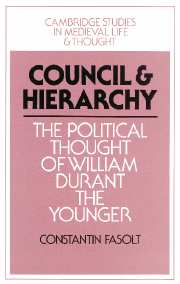Book contents
- Frontmatter
- Contents
- Acknowledgments
- List of abbreviations
- List of manuscript sigla
- INTRODUCTION
- PART I THE FORMATION OF INTEREST
- PART II THE ASSERTION OF JUSTICE
- 4 THE THEORY OF REFORM
- 5 ‘MAGNUS ORDO DIFFERENTIE’
- 6 ‘RES PUBLICA’
- 7 THE PERVERSION OF ORDER
- RESULTS: LIBERTY AND LAW
- PART III THE INCIDENCE OF POWER
- CONCLUSION
- Appendix: A note on texts and citations
- Bibliography
- Concordance
- Index
- Cambridge studies in medieval life and thought Fourth series
RESULTS: LIBERTY AND LAW
Published online by Cambridge University Press: 06 July 2010
- Frontmatter
- Contents
- Acknowledgments
- List of abbreviations
- List of manuscript sigla
- INTRODUCTION
- PART I THE FORMATION OF INTEREST
- PART II THE ASSERTION OF JUSTICE
- 4 THE THEORY OF REFORM
- 5 ‘MAGNUS ORDO DIFFERENTIE’
- 6 ‘RES PUBLICA’
- 7 THE PERVERSION OF ORDER
- RESULTS: LIBERTY AND LAW
- PART III THE INCIDENCE OF POWER
- CONCLUSION
- Appendix: A note on texts and citations
- Bibliography
- Concordance
- Index
- Cambridge studies in medieval life and thought Fourth series
Summary
In Durant's opinion the central obstacle to the reform of the church was the conflict between law and government. In itself, of course, this opinion was by no means new. Ever since the papacy had risen to lead the medieval church there had been doubts about the legitimacy of its policies. One need not turn to the party of the emperor and his Ghibelline supporters or to Cathar heretics to demonstrate the depth of such doubts; St Bernard could not have put it more soberly when he announced that the papal plenitude of power was not the same as a plenitude of justice. Hence thinkers of unquestionably orthodox intentions, with deep roots in the ancient traditions of the church, had attempted to limit papal government long before the days of William Durant. Canonists, not heretics, were responsible for showing that, above and beyond the articles of faith, there was a ‘state of the church’ which the pope was not at liberty to change; canonists, not heretics, taught that a pope who fell into heresy or committed outrageous crimes could be deposed from office; canonists, not heretics, declared that councils were greater than popes.
- Type
- Chapter
- Information
- Council and HierarchyThe Political Thought of William Durant the Younger, pp. 277 - 284Publisher: Cambridge University PressPrint publication year: 1991



